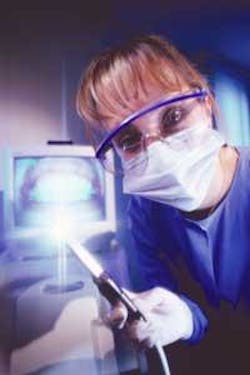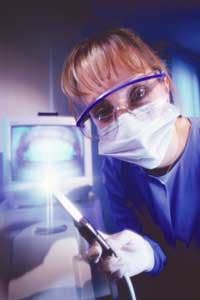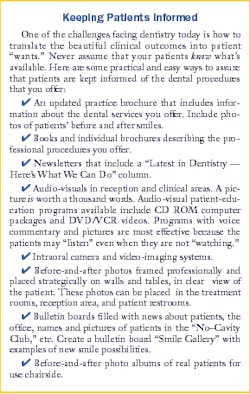Hygiene: up close
by Annette Ashley Linder, BS, RDH
Here is a number to ponder — $1.8 billion! What would you think this number represents? Defense spending? The GDP? The deficit? Perhaps Microsoft's Bill Gates annual income? Answer — None of the above. This number represents the amount of money that the American consumer spent last year on toothpaste (according to A.C. Nielsen). In fact, the Wall Street Journal reports that "whitening toothpastes" accounted for almost 20 percent of all dentifrice sales!
Translation — Americans today are much more health-and-appearance conscious than ever before ... and they are willing to spend money on it! People want to look good, feel good, enjoy the full flavor of their food, and have a bright, healthy smile. Notice all of the commercials on television promoting toothpastes that will "whiten teeth and give you a brighter smile." For the dental professional, this translates into having a wonderful opportunity to offer patients aesthetic and cosmetic treatment options never dreamed of 10 years ago.
Here is how I see this working. The most successful practices in the country incorporate a team approach to introduce appearance-related dentistry to patients. While each member of the dental team must be well-versed and enthusiastic in discussing the benefits of optimum oral health, the hygienist is in a very unique position to assist patients in appreciating the benefits of contemporary aesthetic dentistry. Because the hygienist sees the patient on a continuum — every three, four, or six months — personal and professional relationships develop. Patients often look to the hygienist for help in decision-making. They also frequently ask for her feedback after the dentist has made a treatment recommendation — "Do I really need that? What do you think? What would you do?"
A level of trust and confidence may be so strong that, in some cases, it is life-altering. In my travels throughout the country, I observe this happening quite often. For example, not too long ago, a patient shared a personal experience with me. He said that when he first came to the dental office, he was fearful and anxious. He explained that he never had good teeth, had seen many dentists over the years, and couldn't remember ever having a positive dental experience. For years, he had gone from dentist to dentist, hoping to find a solution, but was always told that he basically had poor teeth and that his ill-fitting partial was the "best that could be done." His daily work activities as a school principal required public speaking and close contact with parents, teachers, and the public at large. He had become so self-conscious about his teeth and appearance that his self-esteem was affected, and it was making his life miserable — so much so that he was actually considering resigning his position! Discouraged and fearful, he said he was "giving it one last try" when referred to my client's dental practice.
He reported that his first visit with the hygienist was unlike anything he had ever experienced. Rapport was established over a series of hygiene appointments during which he confided his concerns. The hygienist described several aesthetic treatment options, utilizing the intraoral camera and "before and after" photos of patients within in the practice. She established such a strong relationship with this patient that it helped him to have confidence in the practice, the doctor, and in dentistry. Ultimately, my client beautifully restored this gentleman's mouth. There also is a "P. S." to the story: This patient became a leading source of referrals to this practice — a true ambassador sending many great, new patients to the office.
This case underscores the huge role of the hygienist in setting the stage for case presentation and enrollment. It also demonstrates the lasting impact on the patient and the practice.
What follows are several easy steps that you can incorporate into your hygiene procedures to boost cosmetic case acceptance.
Patient education
"Know" the patient. The hygienist should review the patient records and past history, identifying "unscheduled dentistry" and prior conversations or discussions regarding cosmetic options. This information can be briefly discussed at the morning huddle, giving the doctor a "heads-up" reminder and soliciting feedback about the patient from other team members.
With this knowledge, the hygienist can prepare appropriate visual-education materials for each patient. Audio-visual computerized patient-education systems (such as CAESY) are set up with the most relevant module, ready to be displayed during the appointment. The ideal time to do this is after preliminary conversation with the patient, while waiting for films to develop, or just before the doctor exam. This gives the hygienist an opportunity to present these ideas and respond to any questions the patient might have.
Intraoral camera or video-imaging systems are up and running all day, every day. The hygienist performs an intraoral examination and makes sure the patient can see the screen so that he or she can ask questions. Pictures are captured on the screen for both the patient and the doctor to see. Many of my clients have established a general guideline for camera utilization, which is: The doctor expects to see at least one image on the monitor when entering the hygiene room. When the doctor arrives for the hygiene exam, the hygienist reports the preliminary findings, indicates patient concerns, and goes over any suggestions she has made. In this way, the doctor knows exactly what has occurred and can continue the dialogue in a timely fashion.
Devote a staff meeting to utilization of the camera or imaging system. Make it productive and fun by role-playing. Each staff member should have the opportunity to play the patient and receive a "comprehensive intraoral tour of the mouth." When was the last time you sat in the dental chair? How does it feel to be the patient? Review your office protocol for an intraoral examination and a tour of the patient's mouth. Every member of the team should be involved. If you don't already have a protocol established, now is the time to do so. Once they are comfortable with using the new equipment, most hygienists would not part with it. It's the best tool for educating, motivating, gaining case acceptance, and obtaining patient compliance.
Asking the questions
Set the stage for discussion by having the patient complete a "Personalized Smile Evaluation." Realizing that time is always a consideration during the hygiene appointment, suggestions and ideas may be offered while performing the clinical procedures. Asking open-ended, easy questions gives the patient the opportunity to reflect and think about appearance-related dentistry and the impact of good dental care on their overall health, appearance, personal, and professional life. Asking questions such as, "On a scale of 1 to 10, how do you feel about your teeth (your smile)?" opens the door for a great listening opportunity for the hygienist to learn about the patient's value system. Ongoing education should include taking the patient on a tour of the mouth with the intraoral camera, offering ideas and discussing treatment options, and making the patient aware of the many benefits of contemporary aesthetic dentistry. Invite the patient to co-examine with you, then begin with a statement such as, "I am so excited about the dentistry that we offer!" This creates a very personal dialogue with the patient. Some other examples of ways to begin the examination process include:
• "I am excited about the dentistry that we offer! The aesthetic (cosmetic) procedures that the doctor provides our patients is nothing short of amazing!" This type of statement invites the patient to co-examine and establishes a very personal dialogue.
• "I would love to share some of the new and beautiful treatment options that are now available to our patients" is both personal and nonthreatening.
• "Have you ever thought about what a brighter smile might do for you?" is a benefit statement that permits patients to consider their total appearance in relationship to their teeth.
• "I am so pleased with our new intraoral camera because it enables you and I to tour your mouth together. Now you can see what I have been seeing (for the last 10 years)."
• "We now have gift certificates available for tooth-whitening. Our patients tell us that it makes a wonderful gift."
Professional placards, framed announcements, signage with messages inviting patients to find out how they can have a brighter smile (tooth-whitening) are other ways to get your message across. I saw some examples of this in the reception area of an office I visited recently:
• "Give the gift of love that lasts. Gift certificates available for tooth-whitening. Give someone special the gift of a brighter smile for less than $1.00 per day!"
• "Valentine's Day is coming! Here is a gift of love for that special someone in your life. Ask us about gift certificates for a brighter smile."
New patient recall exam � status update
When I audit records in dental practices, I find that most of the patients receive a new patient exam when they first enter the practice — and that may have been 10 or 20 years ago! Because of time constraints at the routine dental hygiene (recall) appointment, we tend to keep the patient in the system with a periodic oral exam that does not allow enough time to establish a meaningful dialogue with the patient.
It is amazing the amount of dentistry that is detected, presented, and accepted when there is ample time allotted for a comprehensive, "bring-things-up-to-date-status" exam. Whenever we have an opening in the hygiene schedule (cancellation, failed appointment, or unbooked appointment), the time is efficiently utilized to give the patient in the chair an updated status exam. Extending time with the patient in the chair allows the hygienist to update the radiographs, complete the periodontal examination, tour the mouth with the intraoral camera, display patient-education modules, discuss treatment options, and answer any patient questions.
With a full schedule, the hygienist can set the stage for a comprehensive status examination with the doctor on the next visit. Time can then be programmed into the schedule to allow for the examination. Or, if time permits, include the more comprehensive evaluation as part of the examination scheduled for that day. If the doctor has a change in schedule and is left with open chair time, this patient can be moved to the empty chair and the doctor can perform an extended hygiene check. As a result, what would have been unproductive time is now an opportunity to schedule more treatment and increase practice profitability. One of my clients — a dentist who has been in practice for over 20 years — increased his personal production by 17 percent simply by utilizing extra time in the schedule for comprehensive exams on hygiene patients.
The six-week periodontal evaluation appointment following the completion of the oral exam (4341) and prior to supportive periodontal maintenance (4910) is a valuable appointment and one in which the hygienist maximizes the opportunity for an aesthetic presentation. This appointment is a celebration! The hygienist invites the patient for a tour (by intraoral camera) of the mouth, commenting on how well the tissues have healed and on the success of the periodontal therapy. This is an ideal time to discuss dental needs, appearance dentistry, and aesthetic considerations. (Be sure to advise the patient about the office's "financial helpers," such as Care Credit, Dental Fee Plan, and HelpCard.)
Ideally, patients are involved in their periodontal diagnosis and therapy, and the hygienist strives to educate the patient during the course of treatment. As a result, these patients should be very receptive to learning about a variety of dental alternatives.
One last thing: You should make sure that your hygienist is fully aware of your practice philosophy and your expectations. This is easily accomplished through regularly scheduled hygiene/doctor meetings in which you encourage and support initiative and responsibility. Be sure you keep your hygienist up-to-date about the latest cosmetic materials and services that you provide. You tell her ... she tells the patients ... and this version of the "gossip game" translates into increased profits for the practice!



